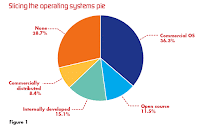 Operating systems. Nothing cuts to the heart of a development project like the choice of OS. Whether it's a tiny scheduler or kernel, an open-source distribution, a tightly wound real-time operating system, a fully featured commercial RTOS, or no OS at all, it drives all downstream software decisions and many hardware decisions as well. There isn't much that all embedded systems have in common but some clear trends is revealed nonetheless.First off, more than a quarter of embedded systems now in development won't have an OS at all. Predictably ,larger organizations tend to use operating systems in their products more often than smaller companies do.
Operating systems. Nothing cuts to the heart of a development project like the choice of OS. Whether it's a tiny scheduler or kernel, an open-source distribution, a tightly wound real-time operating system, a fully featured commercial RTOS, or no OS at all, it drives all downstream software decisions and many hardware decisions as well. There isn't much that all embedded systems have in common but some clear trends is revealed nonetheless.First off, more than a quarter of embedded systems now in development won't have an OS at all. Predictably ,larger organizations tend to use operating systems in their products more often than smaller companies do.
In our 2005 , only 44% of respondents were using a commercial OS, so commercial OS usage has grown significantly. Moreover, that growth is coming at the expense of in-house code.
Both commercial and noncommercial distributions of open-source OSes (mostly Linux) has declined sharply from last year.
- For most, real-time performance is the big issue. Right behind is processor compatibility. In other words, we can't use an OS that hasn't been ported to our preferred microprocessor, microcontroller, or DSP. That makes sense; compatibility is a pass/fail criterion for most developers.
- So it all comes down to this, the all-important ranking of commercial OSes. Among commercial embedded operating systems, Wind River's VxWorks was the undisputed leader, as shown in Figure.

Tied for second place are the Microsoft twins, Windows XP for Embedded and Windows CE (there were separated by one vote). In a predictable reversal, WinXP and WinCE were most popular where VxWorks was weakest: industrial and computer-related applications. XPe was especially strong in manufacturing industries, where VxWorks also made a good showing.
In the number four spot we have Texas Instruments' DSP/BIOS, a product with obvious hardware ties. That's followed by Red Hat's Linux, the first of the many Linux variants to make the list.
- The chart shows the delta between the "would consider" responses and the "using now" responses from the previous graph. In brief, the winners lose and the losers win. How is that possible and what does it all mean?

What we can say with certainty is that about 8% fewer people said they'd consider VxWorks compared with the number using it now. Whether or not those are the same people is impossible to tell.Reflecting a kind of Zen balance, almost all of the middle and low scorers gained share of mind in roughly equal proportion to the share lost by the big players. Whether accidentally or by design, the numbers reflect a zero-sum game.
The overall picture is therefore good for commercial OS suppliers. As the number and type of embedded systems increase, so will the total available market.And although open-source operating systems are well and truly established, with one-fifth of developers using one now, their growth seems to have flattened.What's certain is that the variety of embedded systems—and the operating systems that serve them—will continue to flourish.

No comments:
Post a Comment